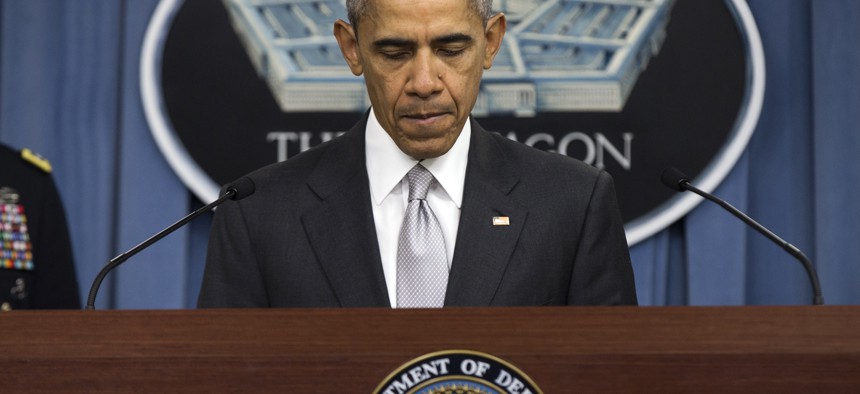
President Obama laid out his vision for fighting ISIS with still-limited military power, Dec. 2015. AP Photo/Evan Vucci
Obama's Legacy: Limited Force, Limited Influence, Lingering Questions of What America Should Be
Obama’s long-view for the Middle East stands little chance of playing out as Americans — and events — cry for the U.S. to do more.
In his State of the Union address, President Barack Obama offered a fervent defense of his view of the role of American power. It’s a view some Republicans and Democrats have derided as offering too little support for America’s allies and too low-calorie a version of what American foreign policy can achieve with focus, resources, and support from the top.
“We…can't try to take over and rebuild every country that falls into crisis even if it's done with the best of intentions.That's not leadership; that's a recipe for quagmire, spilling American blood and treasure that ultimately will weaken us. It's the lesson of Vietnam. It's the lesson of Iraq, and we should have learned it by now,” Obama said after saying that America “is the most powerful nation on earth.”
But in dialing back expectations for what America can and will do, has Obama taken America too far in the other direction, to a slimmed-down version of what is in America’s national interest and what developments warrant America’s intervention? In a world on fire, is America still seen as the reliable ally who can help defuse developments and keep the global order? Does it want to be?
In the medium-term, the upheaval in the Middle East, the fate of the Islamic State, or ISIS, and the bloody war in Syria will be part of determining the Obama foreign policy legacy.
The president said Tuesday night that “when it comes to every important international issue, people of the world do not look to Beijing or Moscow to lead — they call us.” The real question is not whether they call, but whether they believe Washington will pick up the phone and roll up its sleeves in the visible way previous presidents once did.
For years the Obama administration — backed by a cadre of U.S. senior military leaders — monitored the conflict in Syria and determined that it could not be certain that U.S. military intervention in the war would achieve the desired outcomes of either leading to the end of President Bashar al-Assad’s rule or stopping the carnage claiming lives and contributing to the greatest refugee crisis the world has seen since World War II. So America intervened at the edges, offering non-lethal support to the opposition, instituting a covert training program administered by the CIA and, eventually, after years of internal debate, funding a half-billion dollar plan to train and equip rebel forces that ended when the screening and pledges required proved too onerous to generate more than a handful of fighters.
At the heart of the policy was a conversation that began with the premise that America could do nothing to change the outcome of the conflict in Syria. Or as one administration official told Defense One in 2013, “it is a policy of containment, nonintervention at all costs.” And it hasn’t worked.
“What we are seeing is the end result of our inability to contain the conflict in Syria, and it has unfolded in unimaginable ways -- from ISIS to the refugee crisis, no one anticipated this unraveling the way it did,” said Julianne Smith, former deputy national security advisor to Vice President Joe Biden. “It has obviously turned out to be one of, if not the, primary policy challenge for this administration.”
And that policy challenge - in the form of the rise of ISIS and wrenching images of infants starving and parents and toddlers risking their lives to flee the fighting - is one that has forced the administration to defend its approach to limit interventions and learn the hard lessons of the Iraq War. For those who believed the pendulum had swung far too far toward military intervention, there is a great deal of sympathy for the president’s approach.
“Military power gets you halfway there and not much further and creates additional serious complications that have to do with exit strategies,” says former Amb. Thomas Pickering. “I think the president has a realistic sense of what the limitations are on military power; it is a partial tool and not a full tool.”
But if diplomacy is the missing piece, arguably the president’s moment of greatest influence in the Middle East came with his 2009 Cairo speech nearly seven years ago, fresh off his historic presidential campaign, in which he spoke of a “new beginning between the United States and Muslims around the world; one based upon mutual interest and mutual respect.” Today the Middle East peace process is stalled at best, Saudi-Iran relations are worsening, the war in Syria shows no end in sight, Yemen is a humanitarian disaster, and ISIS is a problem that reaches into Europe and, potentially, as far as the United States. Libya is struggling to stabilize and ISIS is growing its footprint there. The regional win the president can point to is the Iran nuclear deal, which his opponents threaten to try and unravel.
What is America’s role in all this upheaval? For the president, there is a third way he has worked to navigate between full-throttled intervention and inaction – and it is on the success of this attempted path that his legacy will be judged. Obama’s legacy, in fact, may be in getting the Middle East to fight terrorism for itself.
“We must chart a more centered course,” Obama said in 2011 during a speech on the “way forward” in Afghanistan. “When threatened, we must respond with force –- but when that force can be targeted, we need not deploy large armies overseas. When innocents are being slaughtered and global security endangered, we don’t have to choose between standing idly by or acting on our own. Instead, we must rally international action, which we’re doing in Libya, where we do not have a single soldier on the ground, but are supporting allies in protecting the Libyan people and giving them the chance to determine their own destiny.”
The Libyan example has hardly proven that a “just right” Goldilocks approach to U.S. foreign policy exists. But in an era of extended wars and multiple deployments, scaling back America’s ambitions for its interventions and its influence has carried the day.
There is some sign the president has seen his own vision begin to be realized, with regional forces playing a role in the counter-ISIS coalition and the Iraqi military pushing hard in Ramadi. All of this is perhaps the seed of a future in which Obama’s vision is realized. But if that is indeed the case, years more patience will be required for regional powers to step in with the resources to lead. And the next president would have to be willing to watch and wait as the carnage continued, threats morphed, and many more fled and died. Short of that, the United States is likely to slow step its way back into the fight. Indeed on the same night as the State of the Union the Army announced it was deploying 1800 troops to Iraq and Afghanistan for advise and assist missions.
For the next president, it is likely to be back to the policy drawing board as events unfold and threats evolve. And the question of whether to return to a bulked-up imaging of what America can and should achieve will return to the fore once more.




